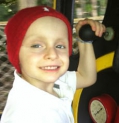DFMO Synergy with Chemo-immunotherapy to Eradicate MYC-Driven Neuroblastoma
Background
Scientists are learning a great deal about how our immune system can find and kill cancer cells and, importantly, how cancer cells have learned to evade this attack. Groundbreaking new treatments that successfully use the immune system to kill certain childhood cancers, like leukemia, have had a hard time killing many common childhood solid tumors. This is because solid tumors create their own environment that acts as a barrier to the body's immune cells. An assortment of tumor-secreted chemicals can cloak the tumor cells to prevent them from being recognized and prevent immune cells from entering the tumor, creating a tumor-supporting microenvironment (TME). We are developing a drug called DFMO to treat high-risk neuroblastoma. DFMO causes stress in neuroblastoma cells by preventing them from making the many proteins needed for cancer to grow and the many chemicals used to create the tumor-permissive TME. We are currently studying DFMO in a Phase 1 trial in combination with chemotherapy for children with relapsed neuroblastoma.
Project Goal
Because of new evidence of an effect of DFMO on the immune-TME and that dinutuximab (an anti-neuroblastoma antibody) has recently shown to be effective when combined with chemotherapy, we propose pre-clinical studies of DFMO with chemotherapy and dinutuximab immunotherapy in complementary mouse models. Our work will define the dose required for anti-tumor activity and the tumor features most correlated with benefit from therapy. We will also provide the pre-clinical rationale for a Phase 2 study in children with relapsed or refractory disease.
Update
The majority of children with neuroblastoma have aggressive tumors. We treat these children with a toxic combination of surgery, chemotherapy, radiation and immunotherapy. Only half of such children are cured, and many survivors suffer lifelong complications. Better treatments are needed and immunotherapy (treatments that help the body's own immune system attack the cancer) holds great promise. Neuroblastoma is the first pediatric solid tumor for which immunotherapy is known to be effective. Dinutuximab is an antibody that attaches to neuroblastoma cells to show the immune system where to attack. The treatment works well enough for FDA-approval yet half of all patients derive little or no benefit. How neuroblastomas escape this immune attack varies from tumor to tumor, and this is influenced by their specific genetic mutations, like whether the tumor has amplified MYCN or an ALK mutation.
We use models of neuroblastoma in which MYCN is activated and study drugs, like DFMO, that alter the immune system to help dinutuximab work better. In addition, we know that chemotherapy can also help the immune system see the tumor. We hope the combination of DFMO with dinutuximab and chemotherapy will have a powerful effect in killing tumor cells. Our laboratories have been working with the Children’s Oncology Group and the New Approaches to Neuroblastoma Therapy consortium to put our findings into practice, and we have opened a clinical trial called ANBL1821 to test these approaches.
In the future, we anticipate treating children with high-risk neuroblastoma very differently. Instead of using high dose chemotherapy alone, we hope to use chemotherapy combined with immunotherapy from the beginning. Depending on the cancer genes found in the tumor, additional drugs like DFMO for MYCN tumors might be added to help the immune system combat the tumor more potently.

